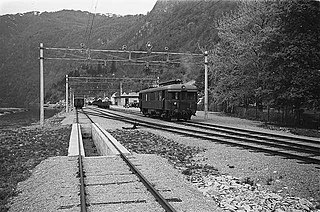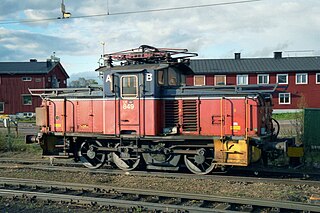
The Norwegian railway system comprises 4,109 km of 1,435 mm track of which 2,644 km is electrified and 274 km double track. There are 697 tunnels and 2,760 bridges.

Vygruppen, branded as Vy, formerly the Norwegian State Railways, branded as NSB, is a government-owned railway company which operates most passenger train services and many bus services in Norway. The company is owned by the Norwegian Ministry of Transport. Its sub-brands include Vy Buss coach services, CargoNet freight trains and the Swedish train transport company Tågkompaniet. In 2009, NSB carried 52 million train passengers and 104 million bus passengers. On 24 April 2019, passenger train and bus services were rebranded as Vy.

The Bergen Line or the Bergen Railway, is a 371-kilometre (231 mi) long scenic standard gauge railway line between Bergen and Hønefoss, Norway. The name is often applied for the entire route from Bergen via Drammen to Oslo, where the passenger trains go, a distance of 496 kilometres (308 mi). It is the highest mainline railway line in Northern Europe, crossing the Hardangervidda plateau at 1,237 metres (4,058 ft) above sea level.

NSB El 18 is a class of 22 electric locomotives built by Adtranz and Swiss Locomotive & Machine Works (SLM) for the Norwegian State Railways (NSB). The class is a modification of the Swiss Federal Railways Re 460 locomotive and built at Adtranz Strømmen in 1996 and 1997. The class remains the only mainline electric locomotive used by NSB, and is predominantly used on some intercity services and all night trains on the Bergen Line, Dovre Line and Sørland Line, as well as some regional trains.

The NSB El 17 is a class of twelve electric locomotives built by Thyssen-Henschel and Norsk Elektrisk & Brown Boveri (NEBB) for the Norwegian State Railways (NSB). The class was built in two batches, the first delivered in 1982 and numbered 2221–2226, and the second delivered in 1987 and numbered 2227–2232. The traction system of the El 17 was based on the DB Class 120 of Germany and were among the first in the world to feature three-phase asynchronous motors. The units were ordered to be used on the intercity Bergen, Dovre and Sørland Lines, but were plagued with technical faults. The unreliability and lack of sufficient power forced NSB to instead use them in the regional Vestfold and Gjøvik Lines. With the delivery of the El 18, the first series was retired or used as shunters. The second series has been used on the Flåm Line since 1998.

NSB Di 4 is a class of five diesel-electric locomotives built by Henschel for the Norwegian State Railways (NSB). Delivered in 1981, the class is used to haul passenger trains on the Nordland Line and are since 2001 the only revenue diesel locomotives used by NSB. The locomotives had electric components from Brown, Boveri & Cie and a General Motors Electro-Motive Division 16-645E prime mover. This gives a power output of 2,450 kilowatts (3,290 hp) and a starting tractive effort of 360 kilonewtons (81,000 lbf).

Norske tog Class 92 is a class of 15 diesel multiple units built by Duewag for the Norwegian State Railways (NSB). The two-car trains were delivered in 1984 and 1985, and were put into service on the Røros Line and southern part of the Nordland Line—which later became the Trøndelag Commuter Rail. Later, they also entered service on the Meråker Line as part of the international Mittnabotåget service. Previously, the trains were also used on the Solør Line, further north on the Nordland Line and on the now electrified Arendal Line. In 2000, a unit was involved in the Åsta accident; which killed 19 people. The trains were refurbished in 2005 and 2006, and NSB plans to replace them by around 2019. Each twin unit seats 168 people, is 49.45 meters long and weighs 92 tonnes. The front car is powered with two electric motors, giving a power output of 714 kilowatts (957 hp) and a maximum speed of 140 kilometers per hour (87 mph).

NSB El 9 is a retired class of three electric locomotives built by Thune for the Norwegian State Railways (NSB), with electrical equipment from Norsk Elektrisk & Brown Boveri (NEBB) and Per Kure. The locomotives were delivered in 1947 after a three-year delay caused by wartime sabotage in response to the German occupation of Norway. They were used nearly exclusively on the Flåm Line and Hardanger Line, two steep branch lines. The units were used on the Flåm Line until 1983, when they were replaced by El 11. They were then used as shunters until being retired in 1988. Two of the locomotives have been preserved.

NSB Di 3 is a class of 35 diesel-electric locomotives built by NOHAB for the Norwegian State Railways (NSB). The class was built between 1954 and 1969, and delivered in two series, Di 3a and Di 3b. They are based on the Electro-Motive Division F7 and are equipped with EMD 567 engines. They have a distinct bulldog nose and were numbered 602–633 (a-series) and 641–643 (b-series). The locomotives had a prime mover that gives a power output of 1,305 kilowatts (1,750 hp). The a-series has a Co′Co′ wheel arrangement, while the b-series has (A1A)(A1A). The b-series has higher top speed, but lower tractive effort.

The NSB Di 8 is a class of diesel-electric locomotives built by Maschinenbau Kiel (MaK), while it was part of Siemens Schienenfahrzeugtechnik, for the Norwegian State Railways (NSB). The locomotives are equipped with a Caterpillar 3516 DI-TA prime mover, which provides a power output of 1,570 kilowatts (2,110 hp) and a starting tractive effort of 270 kilonewtons (61,000 lbf).

NSB Class 66 was a three-car electric train used by the Norwegian State Railways for express trains on the Østfold Line to Halden and Gothenburg, and the Sørlandet Line to Kristiansand and Stavanger. The four multiple units were built by Skabo Jernbanevognfabrikk, with motors from Norsk Elektrisk & Brown Boveri, and delivered in 1945–46. They were originally named Class 106, but this was changed in 1956. The trains received the numbering BFM 66.01–04, B 66.31–34 and BS 66.61–64.

NSB Di 1 was a class of diesel-hydraulic locomotives built by Krupp for the Norwegian State Railways (NSB). The locomotive had two MAN diesel engines, giving a combined power output of 1,472 kilowatts (1,974 hp) and allowing the 82.7 tonnes vehicle to reach a maximum speed of 100 km/h (62 mph). It had a 1'BB'1 wheel arrangement and a driver's cab at only one end.

NSB Di 2 was a class of 54 diesel-hydraulic locomotives operated by the Norwegian State Railways (NSB). Six units were built by Maschinenbau Kiel (MaK) of Kiel, Germany, and the remaining by Thune in Oslo. The locomotives were used for shunting and for local and light freight trains throughout NSBs network. Based on MaK's 575C design, the locomotives were 10.0 meters long and had a C wheel arrangement.

The Solbergfoss Line was a 7.9-kilometer (4.9 mi) railway line which ran from Askim Station to Solbergfoss Power Station, entirely in Askim, Norway. The single-track, standard gauge railway was an industrial railway operated by the power station owned by Oslo Lysverker and the Norwegian Water Resources and Energy Directorate.

NSB Class 64 is a class of three electric multiple units built by Strømmens Værksted for the Norwegian State Railways. Delivered in 1935, they were built for the opening of the Hardanger Line and served there until 1985, when the line closed and the trains were retired. They also periodically served on the Flåm Line. The delivery consisted of three motor cars and four carriages, with each train consisting of up to three units. The motor cars were 16.3 meters (53 ft) long, had a power output of 464 kilowatts (622 hp) and were capable of 50 km/h (31 mph). The motor units were given road numbers 505 through 507. Two of the units have been preserved by the Norwegian Railway Club and are at Garnes Station.

NSB Class 86 is a class of diesel-hydraulic multiple units built by Strømmens Værksted for the Norwegian State Railways (NSB). Thirty-eight motor cars and thirty-one trailers were built between 1937 and 1954, split between six subtypes designated a through f. Class 91 was a further delivery of ten units that had a more comfortable interior and designed for regional trains. The trains had good acceleration and a maximum speed of 100 kilometres per hour (62 mph), which made them suitable for most unelectrified lines in Norway. As most of the network gradually became electrified, the class became increasingly used on branch lines.
NSB Class 87 is a class of 25 diesel-hydraulic railcars built by Strømmens Værksted for the Norwegian State Railways. Seventeen a-series units were delivered in 1941 and equipped with 93-kilowatt (125 hp) Deutz prime mover. Eight b-series units were delivered in 1952 and equipped with 110-kilowatt (150 hp) Scania-Vabis prime movers. The trains weighed 15 and 15.5 tonnes and had a maximum speed of 75 and 80 kilometres per hour, respectively for the a and b-series. They were used on many branch lines until the 1960s, when the gradual electrification caused most lines instead to be served with Class 86. The a-series was scrapped in 1972 and 1973, while the b-series remained used between Ål and Hønefoss on the Bergen Line until 1975 and on the Flekkefjord Line until 1981.
NSB Class 88 was a class of six three-car diesel-hydraulic multiple units built by Strømmens Værksted for the Norwegian State Railways. Derived from the German DRG Class SVT 877, the trains were the diesel counterpart of Class 66. The trains were built as express trains on the Bergen Line and the Dovre Line, serving the routes from Oslo to Bergen and Trondheim. The first four units were delivered in 1945 and 1946, but mechanical failures caused them to highly unreliable until 1950. Two more units were delivered in 1958. Retirement started in 1963 and from 1965 the trains were moved to the Røros Line. They left regular service from 1970 and were chopped three years later.

U is a class of 152 electric shunter locomotives operated by the Swedish State Railways and Trafikaktiebolaget Grängesberg–Oxelösunds Järnvägar (TGOJ) of Sweden, and the Norwegian State Railways (NSB), LKAB and Norsk Jernverk of Norway. They were built by ASEA, Nyqvist och Holm, Motala, ASJ Falun and Thune between 1926 and 1956. NSB gave the class the designation El 10.

Kristine Valdresdatter, officially known as NSB Cmb17a or Class 17, was a single railcar built by Strømmens Værksted in 1935. The train has a Buda gasoline prime mover with a mechanical transmission. This gave a power output of 90 kilowatts (120 hp) and a maximum speed of 100 kilometers per hour (62 mph). Originally delivered to the private Valdres Line. The Norwegian State Railways (NSB) took over the line in 1937. It was used on the Numedal Line from 1939 and the Grimstad Line from 1947. After a derailment in 1955, the railcar was retired and has been scrapped.


















